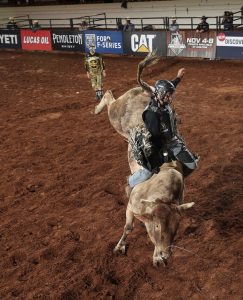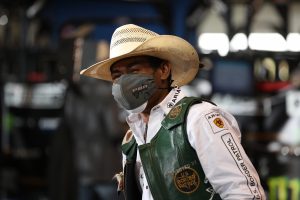No Bull: PBR Embraces Testing, RVs, Social Distancing to Get Back to Action
With strong COVID-19 measures in place, bull riding returns to the live arena
Story Highlights
This weekend the PBR heads to the Lazy E Arena in Guthrie, OK, its second week in action and another chance to continue to refine not only the TV production but also the safeguards and steps the organization has taken to ensure everyone from the TV crews to the venue personnel and those participating in the competition are as safe as possible.

PBR has returned to action with the help of a number of safety protocols designed to ensure that everyone involved in the production is as safe as possible.
It took a lot of work to figure out how best to pull off the production and the entire event and PBR took some unique and innovative steps. First, no one is allowed to fly in for the show. Second, instead of staying in hotels everyone is living in RVs on the spacious ground of the Lazy E Arena. Oh, and everyone better wear a mask, practice social distancing, and stay within their defined functional group.
“We are getting even more rigid and demanding as things like wearing a mask is so foreign for people who are used to being able to talk with each other,” says Robby Greene who oversees all of the TV and production for PBR. “The biggest challenge is making everything a habit, but compliance has been very strong.”
The most unique aspect of the show is that everyone involved with the event is staying in RVs rather than at hotels. The RVs are provided by RV Share and Cruise America (Greene calls RV Share’s app his new favorite) and Greene says the cost is about the same as a hotel room during regular times. And while PBR could have rented out entire hotels and saved money the goal was really to make sure everyone could come in to a secure “bubble,” work as safely as possible, and not mix with the local community.
“It was always about the safety,” he says.

Keyshawn Whitehorse during the second round of the Guthrie Las Vegas Invintational Unleash The Beast PBR. Photo by Andy Watson
RV Share works by sending out notices to RV owners within driving distance that someone would like to rent their RV. The RV is cleaned thoroughly, and the Lazy E Arena can fit up to 400 RVs over 300 acres.
Some of the side benefits of using RVs include that everyone has their own bathroom to use during the show so issues about shared toilet facilities are lessened; there is no need to take a taxi or ride share which again could raise the risk of infection; everyone has their own kitchen; and there are even social benefits.
“I’ve gotten to know some of the people who report to me so much better over a long weekend because we aren’t running from one place to another,” says Greene. “In 24-plus years I have never seen an executive leadership team have this great of a chance to know each other.”
While most TV productions and sports events begin with a flurry of activity the PBR events during a global pandemic begin with a 24-hour time out for everyone as they are first tested for anti-bodies and then given the nasal swab test for the presence of the virus, which takes 24 hours for results to return. During those 24 hours the person who has been swabbed is quarantined to their RV trailer and they have to be completely self-reliant during that period. Once they are cleared, they are good to go but still must maintain social distancing and other safety protocols.
Screenings are done daily for all competitors and crew prior to entering the secure venue grounds and anyone testing positive would immediately go to a trailer reserved for quarantined isolation and, depending on the circumstances, may be sent home immediately. PBR reports no positive tests in its first weekend in action back on April 25-26. Food and other supplies entering the grounds are also screened and sanitized.
To ensure social distancing the production crew is also using things like robotic cameras and TV announcers and judgers are located away from the field of play. The goal is to reduce the number of support personnel and limit the number of stock contractors. Additionally, standard production elements such as pyrotechnics and videoboard are not part of the show.
“The crew size is about 60 percent of normal and it is also voluntary as we know that some people may be anxious about these unprecedented circumstances,” says Greene. “Everyone is aware of the process and the main thing is that if they didn’t feel comfortable, they can choose not to be here.”
Those who are on site are also broken up into 21 smaller functional groups of less than 10 people and an average size of 6.5 people. Each group member wears a colored wrist band that must be visible at all times along with color coded credentials.
“Everyone is given their gloves, mask, and what I like to call their scarlet-letter wristband at check in,” says Greene.
Another step taken to lower risk is that those 21 different groups each have a different place for their meals. Each of those catering areas are 15 feet apart and the assigned area is the only place each team can get their meal.
“The tape room is their own functional group as is the production team with the producer, director, and AD,” says Greene. “We also post the names of people who are allowed into a given confined area.”
Social distancing guidelines are also extended to 10 feet for those not in the same group and six feet for those who are in the same group.
A production can have all of the safeguards in the world, but the glue of PBR’s comprehensive protocols is a social responsibility pledge whereby everyone agrees to behave with a large degree of caution and personal hygiene.
“The majority of our ecosystem are independent contractors and they depend on PBR events to make house payments,” says Greene. “They are our family and we are trying to do what we can to be a business that is socially responsible while bringing back to fans the sport they love.”
